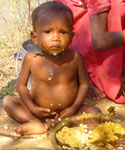Pattinacheri (Tamil Nadu): Of all those left behind helpless by the tsunami attack that left behind a swathe of death and destruction, the orphaned girls in Tamil Nadu, it seems, are the worst affected. Fifteen year-old Mahalaxmi is one of the unfortunate, who after having lost her father in childhood now has to go through the trauma of losing her mother And how cruel could fate be that her sister Sellama’s fianci was washed away on the fateful day? Facing an uncertain future, both the sisters live in a makeshift hut, with the help of neighbours. “We did not have a father and our mother took care of us. But now we have even lost her. I don’t know what will we do now, live or die,” said Sellamma. Mahalaxmi is now a school drop out. “Now it is very difficult for us to continue our education because we have lost everything,” she said. Sellamma and Mahalaxmi are among thousands of orphans living a life without a secured future. The government has given 500,000 rupees for children, orphaned by the tsunami but in most of the cases, the money has not reached the needy. At least 16,000 people were killed in tsunami in India, nearly half of them in Tamil Nadu alone.
Thirteen-year-old Ramaiya watched helplessly as her mother quickly tucked her under a boat, pleading her to hold to it as hard as possible. It was the last the young girl ever heard of her mother. Ramaiya survived the onslaught and wandered for days through her devastated village in Nagapattinam before being picked up by rescuers. Though now in the safe confines of the orphanage, she knows her fisherman father is alive but like dozens others here does not know if he will ever come to take her back. Incoherent and still hazy about what really happened, she is clinging on to the only surety she had in life, – her mother. “I lost my mother, I remember my mother, I lost my mother,” Ramaiya said.
From fishing villages in south India to plush beach resorts in Thailand, too small and weak to run fast enough, to swim or to hold on to safety, kids are the biggest and most tragic victims of the tsunami. UNICEF estimates at least 50,000 of the 144,000 dead are kids. In some of the worst-hit areas, at least three of every four children died, wiping out virtually an entire generation. And even as the children are picking the pieces in relief homes, doctors have been literally swamped by the onslaught and the sheer scale of the trauma. While play has proven as an effective therapy, it is not enough. Though completely normal during day time, most of the children here still cry themselves to sleep, missing the lullabies, bed time stories of their mothers and the pillow fights with their siblings. Doctors also fear that the children could end up silently reenacting scenes of the catastrophe in their minds and avoid anything which reminds them of the disaster, such as going to the beach or watching television news. Counsellors from across the world have rushed to the region to somehow stop the children from being scarred for life.
Prakash Gurnami, a child psychiatrist with the UNICEF, says while individual attention is critical, initially a comprehensive counselling package is first being filtered down to all the child relief centers to arrest immediate damage. “We have developed a comprehensive programme. In the initial phase itself when people are doing relief measures, they realise that this is an important aspect so with the National Institute of Mental Health, we have developed a omplete counselling package which is a basic counselling package which is going down to the relief shelter and the orphanages to ensure that these children come back to normal surroundings,” Gurnami said. Psychiatrists add the survivors will suffer emotional turmoil and grief for months, even years and efforts should be on to get them into the mainstream like going to school, at the earliest, which they say will help them cope better.

